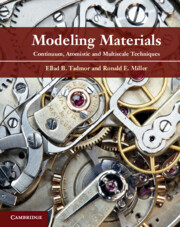Book contents
- Frontmatter
- Contents
- Preface
- Acknowledgments
- Notation
- 1 Introduction
- Part I Continuum mechanics and thermodynamics
- Part II Atomistics
- Part III Atomistic foundations of continuum concepts
- Part IV Multiscale methods
- 10 What is multiscale modeling?
- 11 Atomistic constitutive relations for multilattice crystals
- 12 Atomistic–continuum coupling: static methods
- 13 Atomistic–continuum coupling: finite temperature and dynamics
- Appendix A Mathematical representation of interatomic potentials
- References
- Index
11 - Atomistic constitutive relations for multilattice crystals
from Part IV - Multiscale methods
Published online by Cambridge University Press: 05 June 2012
- Frontmatter
- Contents
- Preface
- Acknowledgments
- Notation
- 1 Introduction
- Part I Continuum mechanics and thermodynamics
- Part II Atomistics
- Part III Atomistic foundations of continuum concepts
- Part IV Multiscale methods
- 10 What is multiscale modeling?
- 11 Atomistic constitutive relations for multilattice crystals
- 12 Atomistic–continuum coupling: static methods
- 13 Atomistic–continuum coupling: finite temperature and dynamics
- Appendix A Mathematical representation of interatomic potentials
- References
- Index
Summary
In this chapter, we derive expressions for the free energy, stress and elasticity tensors for crystalline systems under equilibrium conditions. These expressions can be used as constitutive relations in continuum mechanics (see Section 2.5) under the assumption that a continuum system is in a state of “local thermodynamic equilibrium” at each point. The advantage of the “atomistic constitutive relations” derived here is that they inherently possess basic properties of the material such as its symmetries and lattice-invariant shears which are difficult to incorporate into standard continuum models for crystals. It is also hoped that atomistic models are more predictive than macroscopic phenomenological models, but of course this depends on the transferability of the interatomic model as discussed in Section 5.7.2. The use of atomistic constitutive relations within a continuum finite element framework will be our first example of a multiscale method in Chapter 12.
Chapter 8 has already dealt with the derivation of microscopic expressions for stress and elasticity, so why are we revisiting this problem again? The reason is that the statistical mechanics expressions in Chapter 8 place no restrictions on the positions of the atoms aside from overall macroscopic constraints. This is an excellent model for fluids, where atoms move freely through space. However, in solid systems, atoms are arranged in energetically-favorable patterns about which they vibrate with an overall magnitude dictated by the temperature of the system.
- Type
- Chapter
- Information
- Modeling MaterialsContinuum, Atomistic and Multiscale Techniques, pp. 550 - 600Publisher: Cambridge University PressPrint publication year: 2011



